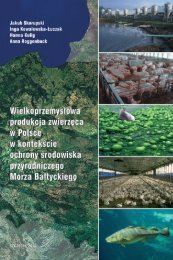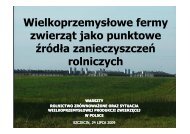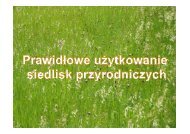best available technologies for manure treatment - Baltic Green Belt
best available technologies for manure treatment - Baltic Green Belt
best available technologies for manure treatment - Baltic Green Belt
You also want an ePaper? Increase the reach of your titles
YUMPU automatically turns print PDFs into web optimized ePapers that Google loves.
Best Available Technologies <strong>for</strong> <strong>manure</strong> <strong>treatment</strong> baltic sea 2020<br />
3: INFORMATION GATHERED<br />
Sweden Finland Estonia Latvia Lithuania Poland Germany Denmark Total<br />
Production<br />
pigs<br />
102 14 34 22 24 116 395 378 1.085<br />
Sows 15 10 - 2 4 6 206 - 243<br />
Total 117 24 34 24 28 122 601 378 1.328<br />
Table 7: Number of IPPC permitted installations <strong>for</strong> the intensive rearing of pigs in <strong>Baltic</strong> Sea Members States<br />
2008 (European Commission, DG Environment, Monitoring of Permitting Progress <strong>for</strong> Existing IPPC Installations,<br />
Final Report, March 2009, Danmarks Statistiks Bibliotek og In<strong>for</strong>mation (personal communication)<br />
3.4.1: The IPPC Directive<br />
The purpose of the Integrated Pollution Prevention<br />
and Control (IPPC) Directive is to achieve integrated<br />
prevention and control of pollution arising from<br />
industrial activities. It lays down measures designed<br />
to prevent or, when that is not practicable, to reduce<br />
emissions in the air, water and land. It came into<br />
<strong>for</strong>ce in 1996, requiring full compliance by 30 October<br />
2007.<br />
Installations <strong>for</strong> the intensive rearing of pigs with<br />
> 2.000 places <strong>for</strong> production pigs (over 30 kg) or<br />
>750 places <strong>for</strong> sows are specified as industrial installations<br />
under regulation of the directive.<br />
The total number of ”IPPC farms” (pigs; sows<br />
and poultry) in the EU-25 is around 16.000. This is<br />
less than 0,1% of the total number of farms in the<br />
EU-25. On these farms, 16% of the total number of<br />
production pigs, 22% of the total number of sows,<br />
and around 60% of the total number of poultry are<br />
kept (2008). There are 1.328 IPPC installations <strong>for</strong><br />
the intensive rearing of pigs in the Member States<br />
surrounding the <strong>Baltic</strong> Sea (Table 7).<br />
The directive requires installations to operate according<br />
to permit conditions based on <strong>best</strong> <strong>available</strong><br />
techniques (BAT), without prescribing the use of any<br />
technique or specific technology and taking into account<br />
the technical characteristics of the installation<br />
concerned, its geographical location and the local<br />
environmental conditions.<br />
The IPPC directive sets no limits regarding emissions<br />
of nutrients from installations <strong>for</strong> the intensive<br />
rearing of pigs, but refers to other Community legislation<br />
to be applied as maximum emission limit vales.<br />
The Nitrate Directive limits the annual amount of<br />
N from livestock <strong>manure</strong> in designated N vulnerable<br />
zones to be maximum 170 kg/ha.<br />
Member States are obliged to ensure that permits<br />
are issued, that they are properly determined and that<br />
operators comply with the conditions in those permits<br />
in order to comply with the legal requirements<br />
of the Directive.<br />
3.4.2: Organisation<br />
The Directorate General in charge of the Environment<br />
within the European Commission (DG ENV) is responsible<br />
<strong>for</strong> the IPPC Directive and its development.<br />
The In<strong>for</strong>mation Exchange Group (IEG) is the<br />
DG ENV advisory group on legal issues related with<br />
the implementation of the IPPC Directive in the<br />
Member States.<br />
The In<strong>for</strong>mation Exchange Forum (IEF) is the<br />
Consultative Committee established by the IPPC Directive<br />
to generally oversee the elaboration of BREFs<br />
and the in<strong>for</strong>mation exchange process. It gives a final<br />
indication to the Commission of its degree of support<br />
<strong>for</strong> final draft BREFs.<br />
The European Member States are responsible <strong>for</strong><br />
implementing the Directive and <strong>for</strong> issuing operating<br />
permits to the installations concerned.<br />
The Technical Working Group (TWG) is composed<br />
of European experts from industry, representatives<br />
from Member States authorities and environmental<br />
non-governmental organizations established<br />
<strong>for</strong> the purpose of elaborating or reviewing reference<br />
28








